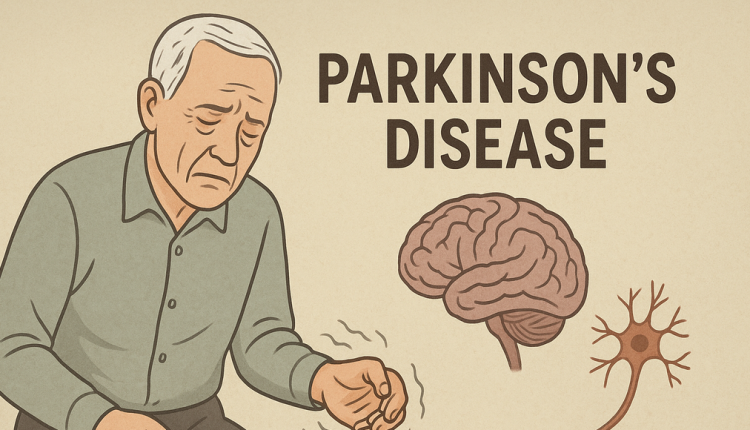Lifestyle-Health
Parkinson’s Disease: Everything you need to know about signs and symptoms

Parkinson’s disease is often thought of as a condition that only affects older people, but understanding it is important for everyone.
Whether you are concerned about a relative, curious about a public figure’s diagnosis, or simply wish to stay informed, here is what you need to know about Parkinson’s disease and how to recognise its signs.
What Is Parkinson’s Disease?
Parkinson’s disease is a neurological disorder that affects movement. It develops when certain brain cells that produce dopamine begin to break down and die. Dopamine is a chemical messenger that helps coordinate smooth and controlled movements. When levels are too low, the body struggles to move as it should.
Recent studies show that approximately 1.2 million people in the United States will be living with Parkinson’s disease by 2030, with around 90,000 new cases diagnosed each year. While it is most common in people over sixty (60), it can also affect younger adults. In fact, between 10% and 20% of those with Parkinson’s receive a diagnosis before the age of fifty (50).
The Main Signs: What to Look For
Symptoms of Parkinson’s usually develop gradually and can be subtle at first. The four (4) key motor symptoms that doctors typically look for are:
Tremors
Tremors are involuntary shaking movements, often beginning in one hand or finger. They typically occur when the person is at rest, such as when sitting down. Interestingly, the tremor often lessens or disappears once movement begins. Not everyone with Parkinson’s experiences tremors, and around 20–30% of patients never develop this symptom.
Bradykinesia (Slow Movement)
Bradykinesia refers to slowed movement. People with Parkinson’s may find it harder to initiate movement, and actions become smaller and less precise. Everyday tasks, such as buttoning a shirt or typing on a phone, may take considerably longer.
Muscle Stiffness (Rigidity)
Muscles may feel stiff and resistant to movement, limiting mobility and sometimes causing pain. This stiffness can reduce arm swings while walking or create a sensation of ‘rusty’ joints.
Balance Problems
Many people with Parkinson’s experience difficulties with balance and coordination. This can increase the risk of falls, affect posture, and make turning movements more challenging. Shoulders may also become hunched forward.
Early Warning Signs You Might Notice
Long before the major movement symptoms appear, some subtle warning signs may emerge, including:
Changes in Handwriting: Writing becomes smaller, cramped, or less legible, a condition known as micrographia.
Loss of Smell: A reduced or lost sense of smell, often occurring years before other symptoms.
Sleep Problems: Restless nights, vivid dreams, or physically acting out dreams.
Voice Changes: Speech may become softer, more monotone, or slurred.
Facial Expression Changes: Reduced expressiveness, sometimes called ‘masked face’.
Constipation: Digestive issues, particularly persistent constipation.
Non-Motor Symptoms That Matter
Parkinson’s is not limited to movement. Many individuals also experience:
Mood Changes: Depression and anxiety, which are part of the condition rather than just emotional reactions.
Cognitive Changes: Difficulties with memory, attention, or decision-making. While dementia is not inevitable, mild cognitive impairment can occur.
Fatigue: Persistent tiredness, even with sufficient rest.
Pain: Muscle cramps, joint discomfort, or generalised pain.
How Symptoms Progress
The progression of Parkinson’s varies widely. Some people live with mild symptoms for many years, while others experience a faster decline. Typically, symptoms begin on one side of the body before gradually affecting both, although one side often remains more impacted.
When to See a Doctor
If you or someone close to you is experiencing several of these symptoms, particularly the main movement-related ones, it is advisable to consult a doctor. Early diagnosis is beneficial as treatments can help manage symptoms and improve quality of life.
It is important not to panic if only one or two symptoms appear. For example, tremors may be caused by caffeine, stress, or medication. The key is to look for patterns and multiple signs occurring together.
Conclusion
Parkinson’s disease is a complex condition that extends beyond movement difficulties. While there is currently no cure, recognising its signs early allows for timely treatment and better management. Medication, physiotherapy, and lifestyle adjustments can significantly improve quality of life.
If you are concerned about symptoms in yourself or a loved one, do not hesitate to seek medical advice. Early intervention can make a meaningful difference. Remember, only a qualified healthcare professional can confirm a diagnosis.
-

 Lifestyle-Health4 months ago
Lifestyle-Health4 months agoInvesting ₹10,000 a month via SIP in this mutual fund would have swelled to ₹1.71 crore in 21 years. Check how
-

 Breaking News4 weeks ago
Breaking News4 weeks agoIsrael Names 77 Countries That Boycotted Netanyahu’s UN Speech In Protest Over Gaza War
-

 Lifestyle-Health4 months ago
Lifestyle-Health4 months agoMultibagger small-cap stock under ₹50 jumps despite sell-off in Indian stock market
-

 News In Diaspora4 months ago
News In Diaspora4 months agoHotels and homes on Crete evacuated as wildfire burns out of control
-

 Lifestyle-Health5 months ago
Lifestyle-Health5 months agoOgie Alcasid’s daughter Leila ties the knot in Australia
-

 Lifestyle-Health4 months ago
Lifestyle-Health4 months agoDriving Abroad: These 34 countries accept SA licenses
-

 Politics5 months ago
Politics5 months agoFinally Federal Government of Nigeria Assures Citizens, Says The President Isn’t Controlled by Any Cabal
-

 Lifestyle-Health2 months ago
Lifestyle-Health2 months ago11 signs of growth that you might have missed
-

 Breaking News2 months ago
Breaking News2 months agoVeteran actress, Peju Ogunmola, loses only child, Ayomikun
-

 Lifestyle-Health4 months ago
Lifestyle-Health4 months ago10 Unwritten Rules for Visiting Bali that Travelers Should Know
-

 Lifestyle-Health2 months ago
Lifestyle-Health2 months agoWhen to take time off and focus on yourself and your family
-

 Lifestyle-Health4 months ago
Lifestyle-Health4 months agoAyala, UPC Renewables JV to sell stake in 1 GW projects in $600 mn deal

